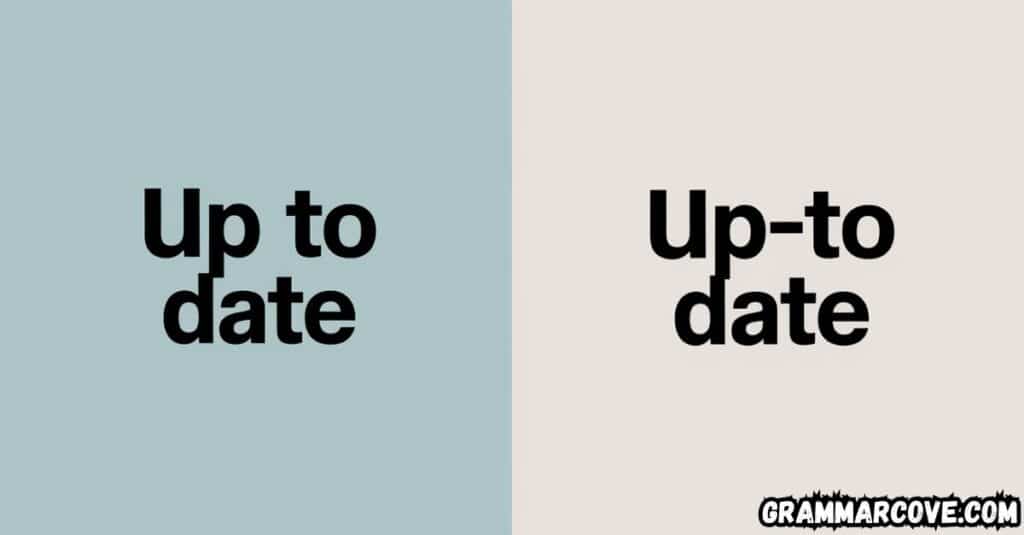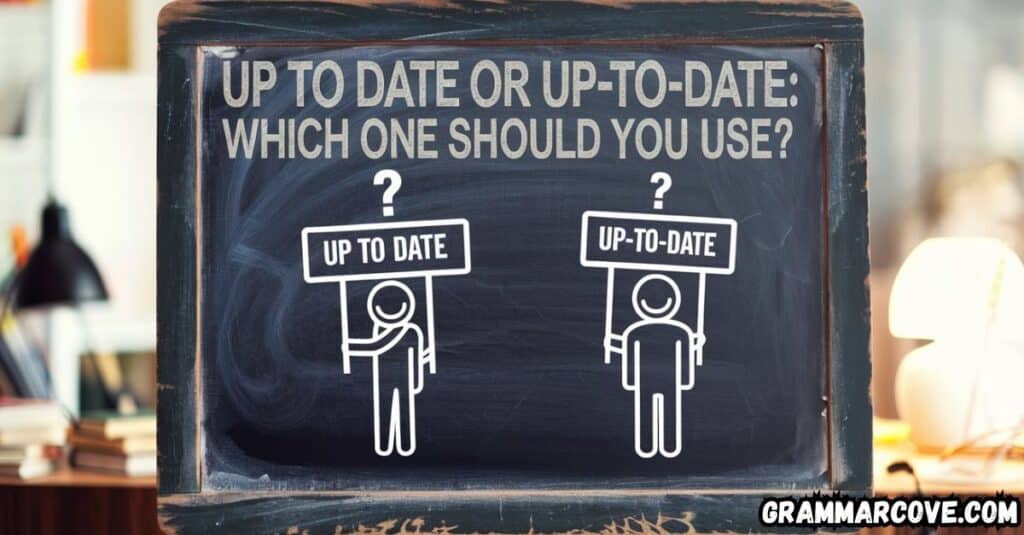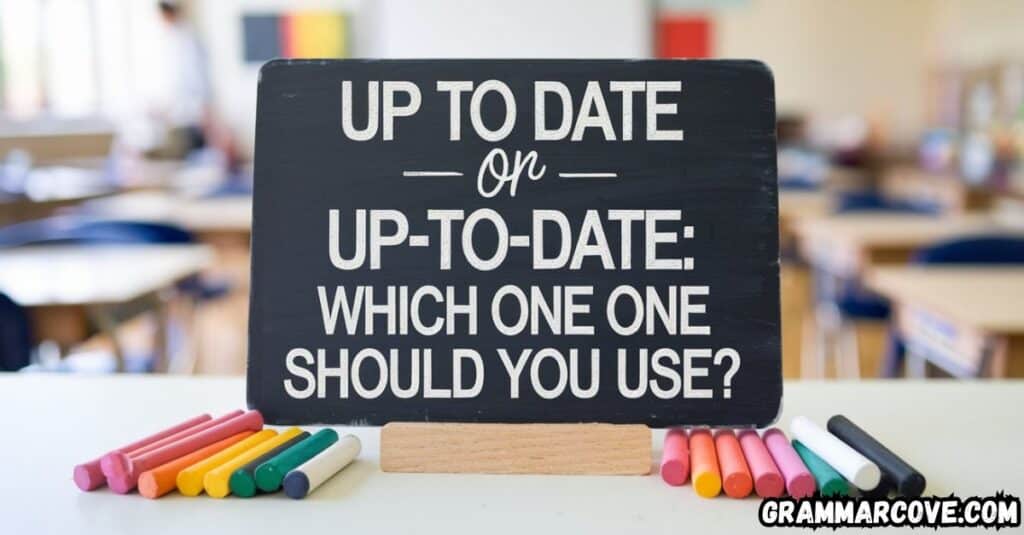When writing in English, a common question many people face is whether to use “up to date” or “up-to-date”. Both versions are widely used, but they serve different grammatical functions and contexts. Understanding the subtle differences between them can make your writing more polished and accurate.
So, let’s dive into the intricacies of hyphenation, grammar rules, and the correct usage of these terms in various situations.
In this article, we will explore when to use “up to date” (without the hyphen) and when to use “up-to-date” (with the hyphen), providing clear examples in different contexts. Whether it’s informal digital communication or professional writing, we’ll cover all the latest trends on this topic and help you decide which one to use in your own English writing.
Understanding the Difference:
Up to Date vs. Up-to-Date
Before delving into the details, it’s important to clarify the fundamental difference between “up to date” and “up-to-date”. In short, “up to date” (without the hyphen) is an adverbial phrase, while “up-to-date” (with the hyphen) is an adjective phrase.
This difference significantly affects how you use these terms in sentences.
Up to Date (Adverbial Phrase)
The phrase “up to date” is typically used when describing something as being modernized or current. It functions as an adverbial phrase that modifies a verb. In this form, “up to date” emphasizes timeliness and current information.
Example:
- Email Scenario: Imagine you are sending a quick email to your colleague, Sarah, about the latest trends in software updates. You might write something like this:“Hi Sarah, just wanted to let you know that the system is up to date with the latest updates. We’re good to go for the next phase.”
Here, “up to date” modifies the verb “is,” indicating the system’s status as being current and updated.
Up-to-Date (Adjective Phrase)
On the other hand, “up-to-date” (with the hyphen) is used as an adjective phrase, describing a noun. It highlights that something is modern, state-of-the-art, or cutting-edge in its design or content. When used as an adjective, the hyphen binds the words together to form a unified idea.
Example:
- Email Scenario: Suppose you are drafting a professional email to a client, Mr. Johnson, to discuss a state-of-the-art report. You might write:“Dear Mr. Johnson, I’ve attached the up-to-date guidelines for the project. It includes all the updated data and modernized strategies.”
Here, “up-to-date” directly modifies “guidelines,” meaning the guidelines are current, relevant, and contemporary.

When Should You Use Hyphenation?
One of the most frequent questions surrounding “up to date” and “up-to-date” is whether up to date is hyphenated. The answer depends on its grammatical role in the sentence.
- Use “up to date” without a hyphen when it functions as an adverbial phrase. This is usually when the phrase is modifying a verb, showing that something is current or modernized.
- Use “up-to-date” with a hyphen when it functions as an adjective phrase. This is typically when it is directly describing a noun.
Example:
Up to Date vs. Up-to-Date
| Context | Correct Usage | Example Sentence |
|---|---|---|
| Describing something modern (adjective) | Up-to-date | “This report is up-to-date, reflecting all the latest trends.” |
| Describing action or state (adverb) | Up to date | “The software is now up to date, having received all the updates.” |
In this table, you can see that “up-to-date” is used when describing the report, whereas “up to date” describes the status of the software.
Correct Usage of Hyphens: English Grammar Rules
Hyphenation in English can often be tricky. The general rule is to hyphenate a compound adjective when it comes before a noun, but not when it comes after a noun. Therefore, if you are using “up-to-date” as a compound adjective before a noun, the hyphen is necessary. However, if the phrase comes after the noun it describes, you don’t need a hyphen.
Example:
- Correct (before noun): “We need up-to-date software.”
- Correct (after noun): “The software is up to date.”
This distinction follows the standard English grammar rules for hyphenation.
Up to Date in Informal Digital Communication
In informal settings, such as text messages or emails between friends or colleagues, “up to date” is often used without the hyphen. This is because informal communication tends to have a more casual style, and clarity can still be maintained without strict adherence to grammatical rules.
Example:
- Text Message Scenario: Suppose you are texting a friend about a mobile app you both use. You might text:“Hey, I just checked the app, and it’s up to date now. Should be running smoothly.”
Here, “up to date” is used as an adverbial phrase, modifying the verb “is.” There’s no need for hyphenation since it’s part of an informal exchange.
Up-to-Date in Professional Writing
When it comes to professional writing, “up-to-date” is typically preferred when describing things like documents, software, or procedures that are modern, current, or cutting-edge. For example, reports, presentations, and business communications should maintain a high standard of professionalism, which is why the hyphenated form is more common in these contexts.
Example:
- Professional Email Scenario: Let’s say you’re sending an update to a project manager, Emily, about some updated software for the team. You might write:“Dear Emily, please find attached the up-to-date software manuals. The team is ready to start using the updated software for the upcoming release.”
The “up-to-date” version here enhances the professionalism of the communication.

Synonyms for Up to Date
Sometimes, using variations can enhance the readability and impact of your writing. If you’re looking for synonyms for “up to date”, consider using terms like “current,” “modernized,” “updated,” or “contemporary.” Here’s a look at some of the best alternatives:
| Synonym | Example Usage |
|---|---|
| Current | “The current information is available on the website.” |
| Modernized | “We’ve modernized the system with the latest technology.” |
| Updated | “The database has been updated to include the most recent data.” |
| Contemporary | “The design is contemporary, using cutting-edge methods.” |
These alternatives help keep your writing fresh and avoid repetition.
Common Mistakes to Avoid
While the distinction between “up to date” and “up-to-date” seems simple, many people make mistakes by using the terms incorrectly. Here are some common mistakes to avoid:
- Using “up to date” as an adjective: For example, writing “I’ve got an up to date report”, when it should be “up-to-date” because it’s modifying report (a noun).
- Using “up-to-date” as an adverb: For example, “The app is up-to-date now.” This should be “up to date” because “up to date” modifies the verb “is.”
- Forgetting the hyphen in professional writing: In professional or formal writing, “up-to-date” is typically the correct form when describing current or modernized elements, such as updated data or state-of-the-art systems.
Conclusion:
Up to Date or Up-to-Date?
In summary, the decision between “up to date” and “up-to-date” ultimately comes down to grammar rules and the context in which the phrase is used. Here’s a quick recap:
- Use “up to date” (without the hyphen) when the phrase functions as an adverbial phrase, describing an action or state.
- Use “up-to-date” (with the hyphen) when the phrase functions as an adjective phrase, describing a noun.
By paying attention to the correct usage, you can avoid common mistakes and make sure your writing stays modern, clear, and professional. So, the next time you’re drafting an email or document, think carefully about whether you’re describing a current situation or a modernized object, and apply the right form accordingly.


